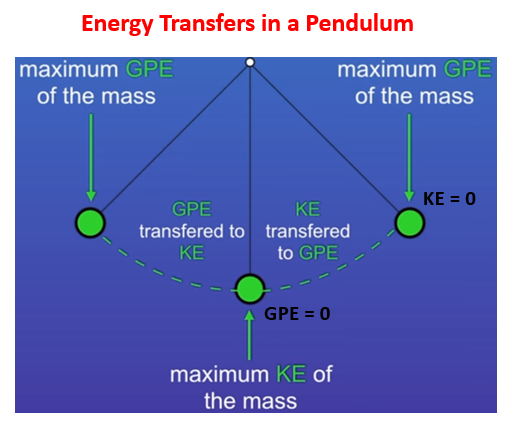Energy Transfers Examples
A series of free GCSE/IGCSE Physics Notes and Lessons.
Energy Transfers: Pendulum
The following diagram shows the energy transfers in a pendulum when it swings. Scroll down the page for more examples and solutions.

In this lesson, we will
- Describe what is meant by conservation of energy.
- Describe how energy can be transfered within a system.
- Describe what happens when energy is dissipated.
The Law of Conservation of Energy states that
Energy can be transfered usefully, stored or dissipated but it cannot be created or destroyed.
In a closed system, no energy can enter or leave.
Friction causes energy to be transfered to thermal energy which is dissipated or wasted.
This will cause the pendulum to gradually swing with less energy and eventually stop.
We can reduce unwanted energy transfers by reducing friction.
Energy transfers: Bungee Jumper
At the start of the jump, all the energy in the system is the store of gravitational potential energy.
As the jumper falls, energy is transferred from the gravitational potential energy store to the kinetic energy store.
When the bungee rope just starts to tighten, the kinetic energy store is now at its maximum.
All the energy has been transferred to elastic potential energy store.
The bungee rope now recoils and energy is transferred from the elastic potential energy store back to the kinetic energy store.
During the ascent, energy transfers from the kinetic energy store back to the gravitational potential energy store.
And finally at the top of the ascent, all of the energy is now in the gravitational potential energy store.
The jumper never returns back to the original position. This is because energy is dissipated as thermal energy.
Pendulum experiment to show the conservation of energy
Try the free Mathway calculator and
problem solver below to practice various math topics. Try the given examples, or type in your own
problem and check your answer with the step-by-step explanations.

We welcome your feedback, comments and questions about this site or page. Please submit your feedback or enquiries via our Feedback page.